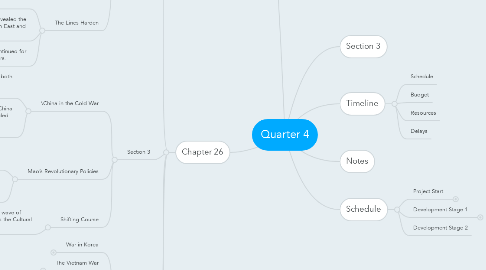
1. Budget
2. Section 3
3. Chapter 26
3.1. Section 2
3.1.1. Signs of Cooperation
3.1.1.1. At first there were hopeful signs that the United States and the USSR might cooperate in the postwar era
3.1.1.2. United Nations : an international organization founded in 1945 to promote peace, security, and cooperation among the world’s nations
3.1.1.3. Together, these two superpowers would dominate world affairs.
3.1.2. U.S.-Soviet Divisions
3.1.2.1. Despite these hopeful signs, deep divisions between the superpowers made lasting cooperation unlikely
3.1.2.2. Some of the differences arose from the war itself.
3.1.2.3. Having been profoundly scarred by the war, the chief aim of the Soviets was to ensure their security
3.1.3. The Emerging Conflict
3.1.3.1. The first obvious signs of trouble appeared in Eastern Europe
3.1.3.2. Meanwhile, the United States was devising policies to counter Soviet power.
3.1.3.3. This support for countries seeking to resist communist influence was known as the Truman Doctrine. It became a key principle in U.S. Cold War policy
3.1.4. The Lines Harden
3.1.4.1. Europe was divided between the communist East and capitalist West
3.1.4.2. These mutual defense pacts revealed the rising military tensions between East and West.
3.1.4.3. The Cold War continued for more than 40 years.
3.2. Section 3
3.2.1. \China in the Cold War
3.2.1.1. The triumph of communism in China took both the United States and the Soviet Union by surprise.
3.2.1.2. Over the next few years, Mao consolidated his control over China and expanded China’s borders. In 1950, Chinese forces invaded and occupied Tibet, a land with a long history of Chinese influence
3.2.2. Mao’s Revolutionary Policies
3.2.2.1. placed power in the hands of the Communist Party and began to restructure the economy based on Marxist principles.
3.2.2.2. The government also socialized industry, putting most factories under state ownership.
3.2.3. Shifting Course
3.2.3.1. China was soon engulfed in a wave of revolutionary turmoil known as the Cultural Revolution
3.3. Section 4
3.3.1. War in Korea
3.3.1.1. he first major battle of the Cold War took place in Korea.
3.3.1.2. 1950, North Korea invaded the south with Soviet and Chinese backing. The United States responded immediately by sending troops to defend South Korea.
3.3.2. The Vietnam War
3.3.2.1. The next major conflict arose in Vietnam.
3.3.2.2. Vietnam was divided into a communist north—backed by China and the USSR—and an anti-communist south, backed by the United States.
3.3.3. Troubles in Latin America
3.3.3.1. Latin America also became a battleground in the Cold War
3.3.3.2. The first Cold War incident in Latin America occurred in Guatemala.
3.3.4. Tensions in the Middle East
3.3.4.1. Cold War conflict also erupted in the Middle East. Egypt was the site of the first crisis.
3.3.4.2. Iran was another hot spot.
3.3.5. Conflicts in Sub-Saharan Africa
3.3.5.1. the superpowers also got involved in wars in various parts of Africa, including Angola and Ethiopia.
3.3.5.2. But the power struggle between the United States and the USSR exacerbated those wars and made them more deadly.
3.4. Section 5
3.4.1. Challenges to Soviet Power
3.4.1.1. In October 1956, Hungarians mounted a revolt against their government and its Soviet backers.
3.4.1.2. Meanwhile, thousands of Eastern Europeans tried to flee to a better life in the West.
3.4.2. Easing Cold War Tensions
3.4.2.1. By the 1970s, Cold War tensions began to ease up.
3.4.2.2. As a result, both nations sought ways to curb the arms race and reduce the risk of nuclear conflict.
3.4.3. The Afghan War
3.4.3.1. sent in troops to occupy the country and prop up the regime.
3.4.4. The Soviet Decline
3.4.4.1. The state-run Soviet economy could not compete with the private enterprise system of the capitalist West.
3.4.4.2. Mikhail Gorbachev (mik-ah-IL GOR-beh-CHOF) was a dynamic reformer who was determined to change the Soviet system.
4. Notes
5. Schedule
5.1. Project Start
5.1.1. Project specifications
5.1.2. End User requirements
5.1.3. Action points sign-off
5.2. Development Stage 1
5.2.1. Define actions as necessary
